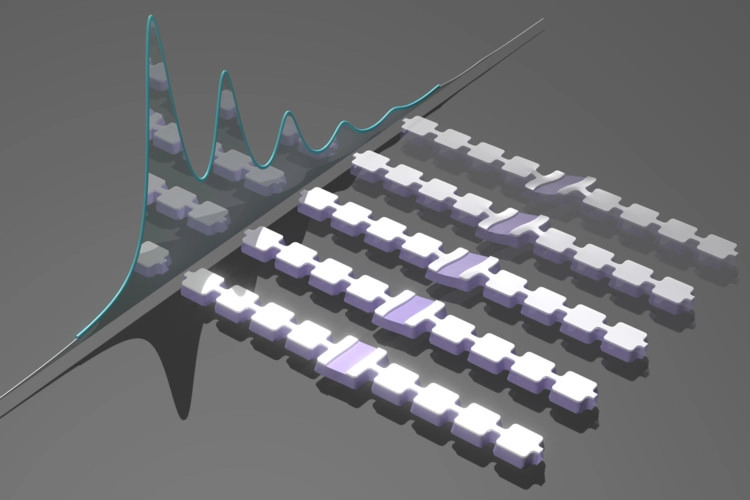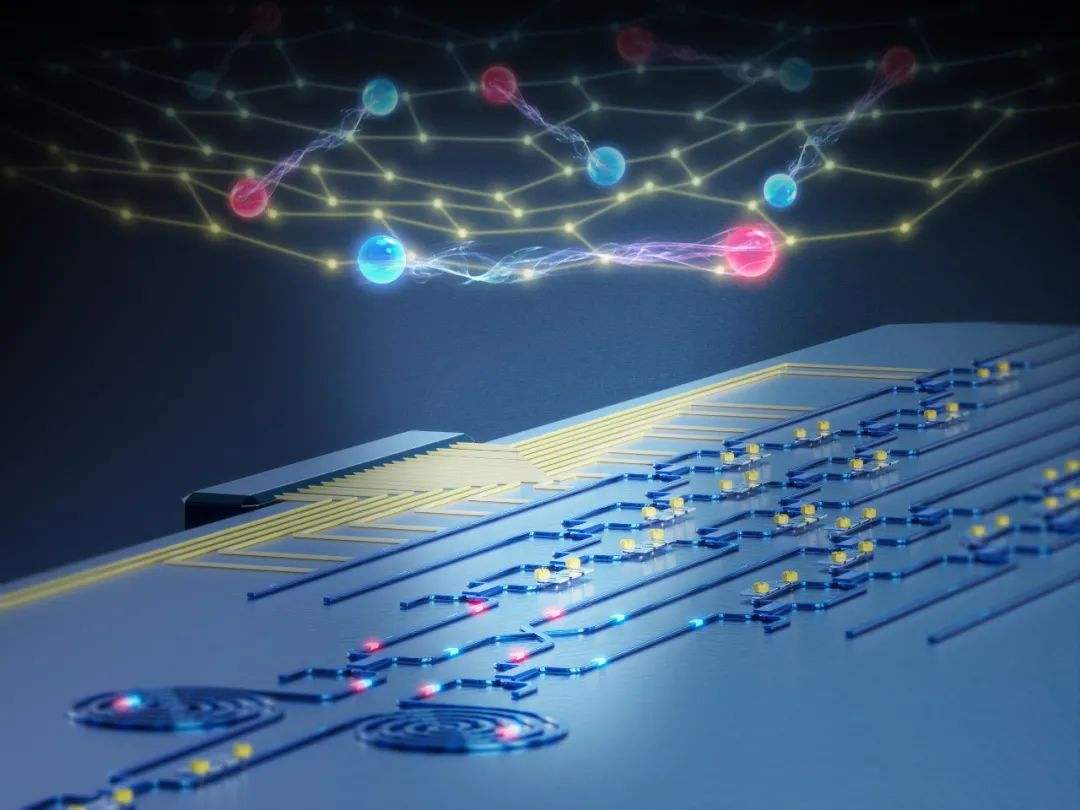创新背景
1907年,阿尔伯特·爱因斯坦首次提出声子,声子是由抖动的原子发出的振动能量包。这些不可分割的运动包,或运动的量子表现为声音或热量,取决于它们的频率。
就像光的量子载体光子一样,声子是量子化的,这意味着它们的振动能量被限制为离散值——类似于楼梯是由不同的台阶组成的。
到目前为止,科学家们还不能直接测量工程结构中的声子状态,因为状态之间的能量差异——在阶梯类比中,台阶之间的间距——是微乎其微的。一个声子所对应的能量比让一个灯泡亮一秒钟所需的能量小十万亿亿倍。
为了解决这个问题,斯坦福大学的研究小组设计了世界上最灵敏的麦克风——一个利用量子原理窃听原子耳语的麦克风。
创新过程
斯坦福大学的物理学家开发了一种“量子麦克风”,这种麦克风非常灵敏,可以测量被称为声子的单个声音粒子。
一个机械系统的能量可以表示为不同的“福克”(Fock)状态——0、1、2等等——基于它产生的声子的数量。例如,“1福克态”由一个具有特定能量的声子组成,“2福克态”由两个具有相同能量的声子组成,以此类推。声子状态越高,声音越响。

被捕获的声子的机械运动被量子位探测器感知到,它的频率根据谐振腔中声子的数量而变化。不同的声子数可以在量子比特谱中看到不同的峰值。
在普通的麦克风中,传入的声波震动内部膜,而这种物理位移被转换成可测量的电压。这种方法不适用于探测单个声子,因为根据海森堡不确定性原理,如果不改变一个量子物体的位置,就无法精确地知道它。
如果试图用一个普通的麦克风测量声子的数量,测量的行为会向系统注入能量,而这种能量恰恰掩盖了试图测量的能量。相反,物理学家们设计了一种方法来直接测量声波中的福克态——也就是声子的数量。
该团队开发的量子麦克风由一系列过冷纳米机械谐振器组成,它们非常小,只有通过电子显微镜才能看到。谐振器被耦合到一个超导电路中,其中包含无电阻运动的电子对。该电路形成了一个量子比特,或称量子位,它可以同时存在于两种状态,并具有一个可以电子读取的固有频率。当机械谐振器像鼓面一样振动时,它们会产生不同状态的声子。
共振器是由周期性结构形成的,就像声音的镜子。通过在这些人工晶格中引入缺陷,研究人员可以将声子困在结构中间。当量子比特的频率和谐振器的频率几乎相同时,量子比特对位移的敏感性特别强。
然而,通过失谐系统,使量子比特和谐振子以非常不同的频率振动,研究人员削弱了这种机械连接,触发了一种量子相互作用,称为色散相互作用,直接将量子比特和声子连接起来。

这个键使量子比特的频率与谐振腔中声子的数量成比例地改变。通过测量量子比特的调谐变化,研究人员可以确定振动谐振器的量子化能级——有效地分辨声子本身。
不同的声子能级在量子比特光谱中表现为不同的峰值。这些峰值对应于0、1、2等福克态。这些多峰是以前从未见过的。
创新关键点
该团队开发的量子麦克风由一系列过冷纳米机械谐振器组成,它们非常小,只有通过电子显微镜才能看到。谐振器被耦合到一个超导电路中,其中包含无电阻运动的电子对。该电路形成了一个量子比特,或称量子位,它可以同时存在于两种状态,并具有一个可以电子读取的固有频率。当机械谐振器像鼓面一样振动时,它们会产生不同状态的声子。
创新价值
掌握精确生成和检测声子的能力有助于为新型量子设备铺平道路,这些设备能够存储和检索编码为声音粒子的信息,或者能够在光学和机械信号之间无缝转换。
这种设备或许可以比使用光子的量子机器更紧凑、更高效,因为声子更容易操作,波长比光粒子小数千倍。
Innovative development of "quantum microphones" to count sound particles
Physicists at Stanford University have developed a "quantum microphone" that is so sensitive it can measure individual sound particles called phonons.
The energy of a mechanical system can be expressed in different "Fock" states -- 0, 1, 2, and so on -- based on the number of phonons it produces. For example, a "1-Fokker state" consists of one phonon with a particular energy, a "2-Fokker state" consists of two phonons with the same energy, and so on. The higher the phonon state, the louder the sound.
In a normal microphone, incoming sound waves vibrate the internal membrane, and this physical displacement is converted into a measurable voltage. This method is not suitable for detecting individual phonons because, according to the Heisenberg uncertainty principle, a quantum object cannot be known precisely without changing its position.
If you try to measure the number of phonons with an ordinary microphone, the act of measuring will inject energy into the system that will mask the energy being measured. Instead, physicists devised a way to directly measure the number of Fokker states -- that is, phonons -- in sound waves.
The quantum microphone developed by the team consists of a series of supercooled nanomechanical resonators that are so small that they can only be seen through an electron microscope. The resonator is coupled to a superconducting circuit containing pairs of electrons moving without resistance. The circuit forms a quantum bit, or qubit, that can exist in two states at once and has a natural frequency that can be read electronically. When mechanical resonators vibrate like a drum, they produce phonons in different states.
Resonators are formed by periodic structures, like mirrors of sound. By introducing defects into these artificial lattices, researchers can trap phonons in the middle of the structure. The qubit is particularly sensitive to displacement when the frequency of the qubit and the resonator are almost the same.
However, by detuning the system to make the qubit and harmonic oscillator vibrate at very different frequencies, the researchers weakened this mechanical connection, triggering a quantum interaction, called a dispersive interaction, that directly connects the qubit to the phonon.
This bond causes the frequency of the qubit to change proportionally to the number of phonons in the resonator. By measuring the tuning changes in the qubits, researchers can determine the quantized energy levels of the vibrational resonators -- effectively resolving the phonons themselves.
Different phonon levels appear as different peaks in the qubit spectrum. These peaks correspond to Fokker states such as 0, 1, and 2. These multiple peaks have never been seen before. Innovative development of "quantum microphones" to count sound particles
智能推荐
传感器技术创新思维 | 创新开发“生物传感器”可结合超声波成像酶活性
2022-10-25因为一项基于基因工程的新突破,研究人员开发新型生物传感器能够使用超声波来观察细胞内酶的工作。
涉及学科涉及领域研究方向成像技术创新思维 | 利用声学报告基因可完成超灵敏超声成像
2022-10-13科学家们利用声学报告基因可以进行超灵敏的超声成像,进而了解有机体中少数细胞的行为。
涉及学科涉及领域研究方向